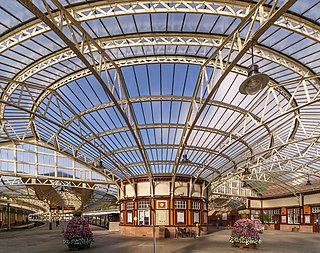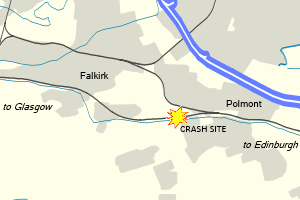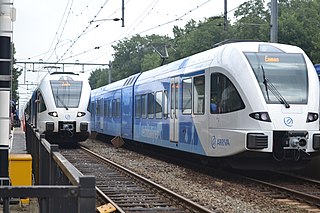Related Research Articles

The Class 66 is a type of six-axle diesel electric freight locomotive developed in part from the Class 59, for use on the railways of the UK. Since its introduction the class has been successful and has been sold to British and other European railway companies. In Continental Europe it is marketed as the EMD Class 66 (JT42CWR).
The town of Morpeth in Northumberland, England has what is reputed to be the most severe curve of any main railway line in Britain. The track turns approximately 98° from a northwesterly to an easterly direction immediately west of Morpeth Station on an otherwise fast section of the East Coast Main Line railway. This was a major factor in three serious derailments between 1969 and 1994. The curve has a permanent speed restriction of 50 miles per hour (80 km/h). This led to the introduction of triangular speed warning boards with a yellow outline, sometimes referred to as Morpeth Boards, after this location, as well as these being accommodated with an AWS horn in the train driver's cabin to alert them of the warning.

The British Rail Class 303 electric multiple units, also known as "Blue Train" units, were introduced in 1960 for the electrification of the North Clyde and the Cathcart Circle lines in Strathclyde. They were initially classified as AM3 units before the introduction of the TOPS classification system, and were the dominant EMU on the Glasgow suburban railway network for over 25 years before being progressively phased out by newer rolling stock. The final units were withdrawn from service in 2002. The fleet's lifespan was 42 years.

In the Salisbury rail crash of 1 July 1906, a LSWR boat train from Plymouth's Friary railway station to London Waterloo station failed to navigate a very sharp curve at the eastern end of Salisbury railway station. The curve had a maximum permitted speed of 30 miles per hour (48 km/h), but the express had been travelling at more than 70 miles per hour (110 km/h). The train was completely derailed, and smashed into a milk train and a light engine, killing 28 people.

Wemyss Bay railway station serves the village of Wemyss Bay, Inverclyde, Scotland. The station is a terminus on the Inverclyde Line, about 26 miles (42 km) west of Glasgow Central. The station incorporates the Caledonian MacBrayne ferry terminal connecting mainland Scotland to Rothesay on the Isle of Bute. The station is managed by Abellio ScotRail.

The Polmont rail accident, also known as the Polmont rail disaster, occurred on 30 July 1984 to the west of Polmont, near Falkirk in Scotland, when a westbound push-pull express train travelling from Edinburgh to Glasgow struck a cow which had gained access to the track through a damaged fence from a field near Polmont railway station. The collision caused all six carriages and the locomotive of the train to derail, killing 13 people and injuring 61 others. The accident led to a debate about the safety of push-pull trains on British Rail.

Falls of Cruachan railway station is a railway station located at the foot of Ben Cruachan in Scotland. This station is on the Oban branch of the West Highland Line, originally part of the Callander and Oban Railway.

In Lockington, England on 26 July 1986, the 09:33 passenger train from Bridlington to Kingston upon Hull on the Hull to Scarborough Line struck a passenger van on a level crossing.
The 1995 Ais Gill rail accident occurred near Aisgill, Cumbria, UK, at about 18:55 hrs on 31 January 1995 when a class 156 Super-Sprinter was derailed by a landslide on the Settle-Carlisle Railway line and was subsequently run into by a similar train travelling in the opposite direction. The conductor of the first train, Mr Stuart Wilson was fatally injured in the collision.
The Bridge of Weir Railway was an independent railway company that built a line from Johnstone to Bridge of Weir. It was taken over by the Glasgow and South Western Railway (G&SWR) in 1865 and formed the base of a line that extended to Greenock, giving the G&SWR access to the harbour facilities there, competing with the rival Caledonian Railway.
The Greenock and Wemyss Bay Railway was a railway owned by the Caledonian Railway, providing services between Greenock and Wemyss Bay.
The railways of New South Wales, Australia have had many incidents and accidents since their formation in 1831..

The 2015 Oxnard train derailment occurred on February 24, 2015 when a Metrolink passenger train collided with a truck on a grade crossing and derailed at Oxnard, California, United States. The train engineer died from his injuries a week later and 29 others were injured.

The Dalfsen train crash occurred on 23 February 2016 when a passenger train collided with a tracked elevated work platform on a level crossing at Dalfsen, Overijssel, Netherlands. One person was killed and six were injured, one seriously.
References
- ↑ "Police treat train-crash deaths as murder". The Independent. 27 June 1994. Retrieved 9 July 2019.
- 1 2 Stephen 2019, p. 82.
- ↑ "Accident at Greenock on 25th June 1994 :: The Railways Archive". www.railwaysarchive.co.uk. Retrieved 9 July 2019.
- ↑ Stephen 2019, pp. 82–83.
- ↑ "Schoolgirl tells murder trial of train crash 'joke'". Herald Scotland. 17 December 1994. Retrieved 9 July 2019.
- 1 2 Stephen 2019, p. 83.
- ↑ "Concrete left on railway line". Greenock Telegraph. 19 January 2011. Retrieved 9 July 2019.
- ↑ "15 years for the railway killers' act of vandalism". Herald Scotland. 23 December 1994. Retrieved 9 July 2019.
- ↑ Child Vandals blamed for growing toll of rail havoc - Daily Mail, 15 August 1997, via findarticles.com
- ↑ "Rail killers stay in jail. - Free Online Library". www.thefreelibrary.com. 27 September 1996. Retrieved 9 July 2019.
Sources
- Stephen, Paul (19 June 2019). "The vandalism that claimed two lives". Rail Magazine. No. 881. Peterborough: Bauer Media. ISSN 0953-4563.
Coordinates: 55°56′28″N4°46′25″W / 55.94105°N 4.77365°W
| This Scottish history-related article is a stub. You can help Wikipedia by expanding it. |
| This Scotland rail transport related article is a stub. You can help Wikipedia by expanding it. |